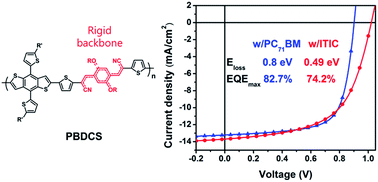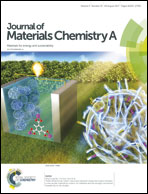A stereoregular β-dicyanodistyrylbenzene (β-DCS)-based conjugated polymer for high-performance organic solar cells with small energy loss and high quantum efficiency†
Abstract
A challenge in organic solar cell (OSC) research is the minimization of the photon energy loss (Eloss), which limits the power conversion efficiency (PCE). Here, we describe the development of a new stereoregular β-dicyanodistyrylbenzene (β-DCS)-based polymer (PBDCS), consisting of trans-isomeric β-DCS and two-dimensional benzodithiophene (2D-BDT), that has a deep HOMO of −5.59 eV and a low band gap of 1.75 eV. Interestingly, PBDCS exhibited 100% trans-stereoregularity and, because of its unique resonance structure and aggregation properties, no trans-to-cis photoisomerization on exposure to UV light. Subsequently, an OSC based on PBDCS:PC71BM was found to have a JSC of 15 mA cm−2 and a high VOC of 0.95 V, resulting in a relatively low Eloss of 0.80 eV with an EQEmax of 82.7%, and a PCE of 8.75%. Furthermore, the OSC based on PBDCS:ITIC exhibited a PCE of 7.81% with a remarkably high VOC of 1.08 V and a JSC of 15.9 mA cm−2. In addition, the OSC has an extremely small Eloss of 0.49 eV despite the high EQEmax of 74.2%. This Eloss is the smallest Eloss value in an efficient OSC. In addition, these results suggest that β-DCS is a suitable acceptor moiety for OSCs with small Eloss values.



 Please wait while we load your content...
Please wait while we load your content...